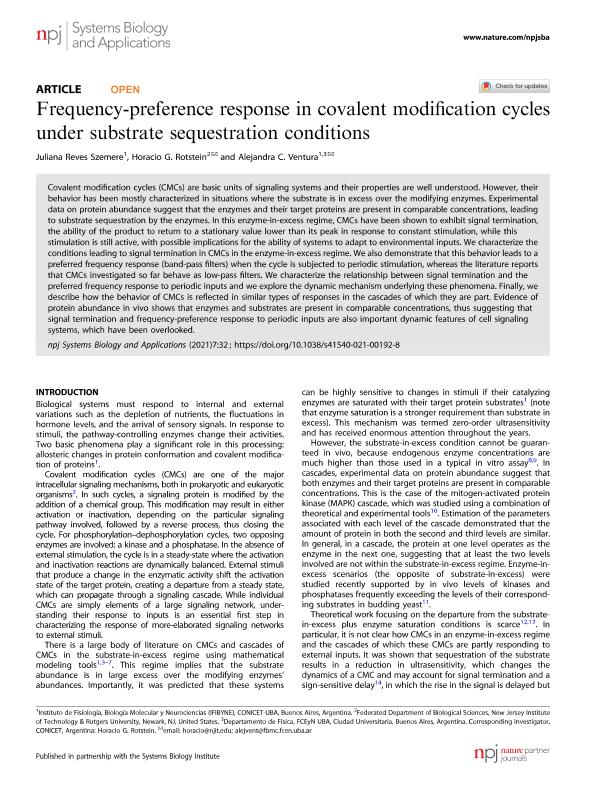Mostrar el registro sencillo del ítem
dc.contributor.author
Reves Szemere, Juliana

dc.contributor.author
Rotstein, Horacio

dc.contributor.author
Ventura, Alejandra

dc.date.available
2022-10-27T16:25:03Z
dc.date.issued
2021-08
dc.identifier.citation
Reves Szemere, Juliana; Rotstein, Horacio; Ventura, Alejandra; Frequency-preference response in covalent modification cycles under substrate sequestration conditions; Nature; Systems Biology and Applications; 7; 1; 8-2021; 1-18
dc.identifier.issn
2056-7189
dc.identifier.uri
http://hdl.handle.net/11336/175221
dc.description.abstract
Covalent modification cycles (CMCs) are basic units of signaling systems and their properties are well understood. However, their behavior has been mostly characterized in situations where the substrate is in excess over the modifying enzymes. Experimental data on protein abundance suggest that the enzymes and their target proteins are present in comparable concentrations, leading to substrate sequestration by the enzymes. In this enzyme-in-excess regime, CMCs have been shown to exhibit signal termination, the ability of the product to return to a stationary value lower than its peak in response to constant stimulation, while this stimulation is still active, with possible implications for the ability of systems to adapt to environmental inputs. We characterize the conditions leading to signal termination in CMCs in the enzyme-in-excess regime. We also demonstrate that this behavior leads to a preferred frequency response (band-pass filters) when the cycle is subjected to periodic stimulation, whereas the literature reports that CMCs investigated so far behave as low-pass filters. We characterize the relationship between signal termination and the preferred frequency response to periodic inputs and we explore the dynamic mechanism underlying these phenomena. Finally, we describe how the behavior of CMCs is reflected in similar types of responses in the cascades of which they are part. Evidence of protein abundance in vivo shows that enzymes and substrates are present in comparable concentrations, thus suggesting that signal termination and frequency-preference response to periodic inputs are also important dynamic features of cell signaling systems, which have been overlooked.
dc.format
application/pdf
dc.language.iso
eng
dc.publisher
Nature

dc.rights
info:eu-repo/semantics/openAccess
dc.rights.uri
https://creativecommons.org/licenses/by/2.5/ar/
dc.subject
FREQUENCY
dc.subject
PREFERENCE
dc.subject
SEQUESTRATION
dc.subject
PHOSPHORILATYON
dc.subject.classification
Biología

dc.subject.classification
Ciencias Biológicas

dc.subject.classification
CIENCIAS NATURALES Y EXACTAS

dc.title
Frequency-preference response in covalent modification cycles under substrate sequestration conditions
dc.type
info:eu-repo/semantics/article
dc.type
info:ar-repo/semantics/artículo
dc.type
info:eu-repo/semantics/publishedVersion
dc.date.updated
2022-09-23T14:24:22Z
dc.journal.volume
7
dc.journal.number
1
dc.journal.pagination
1-18
dc.journal.pais
Reino Unido

dc.description.fil
Fil: Reves Szemere, Juliana. Consejo Nacional de Investigaciones Científicas y Técnicas. Oficina de Coordinación Administrativa Ciudad Universitaria. Instituto de Fisiología, Biología Molecular y Neurociencias. Universidad de Buenos Aires. Facultad de Ciencias Exactas y Naturales. Instituto de Fisiología, Biología Molecular y Neurociencias; Argentina
dc.description.fil
Fil: Rotstein, Horacio. New Jersey Institute of Technology; Estados Unidos
dc.description.fil
Fil: Ventura, Alejandra. Consejo Nacional de Investigaciones Científicas y Técnicas. Oficina de Coordinación Administrativa Ciudad Universitaria. Instituto de Fisiología, Biología Molecular y Neurociencias. Universidad de Buenos Aires. Facultad de Ciencias Exactas y Naturales. Instituto de Fisiología, Biología Molecular y Neurociencias; Argentina
dc.journal.title
Systems Biology and Applications
dc.relation.alternativeid
info:eu-repo/semantics/altIdentifier/url/https://www.nature.com/articles/s41540-021-00192-8
dc.relation.alternativeid
info:eu-repo/semantics/altIdentifier/doi/http://dx.doi.org/10.1038/s41540-021-00192-8
Archivos asociados
